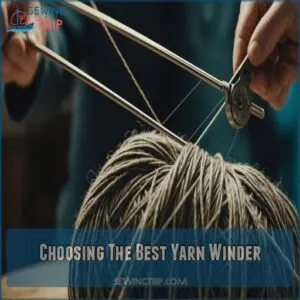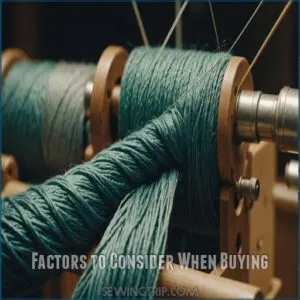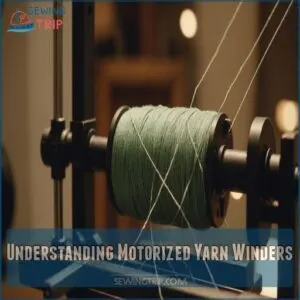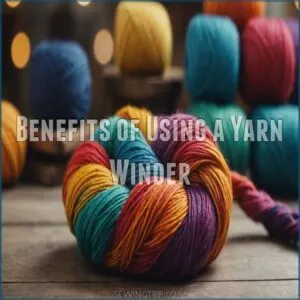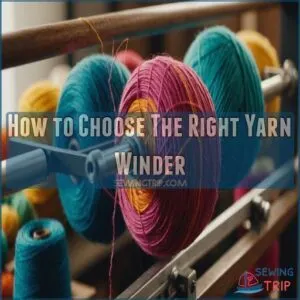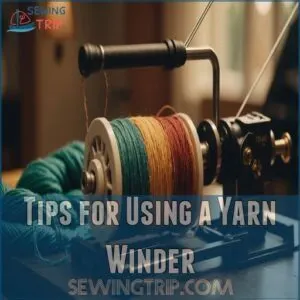This site is supported by our readers. We may earn a commission, at no cost to you, if you purchase through links.
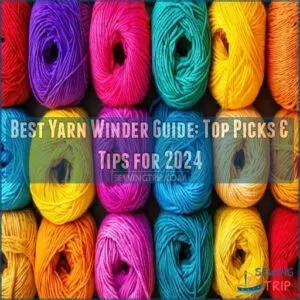 You’ve decided to conquer yarn chaos, so finding the best yarn winder is your ticket to tidiness.
You’ve decided to conquer yarn chaos, so finding the best yarn winder is your ticket to tidiness.
Consider whether a manual or electric option suits your style.
While manuals keep things simple and silent, electrics zip through skeins with ease.
Wooden models add charm (and sturdiness), but lightweight plastic may be your speed if portability is key.
Also, think about the size of cakes you want and how easy it is to set up.
With a bit of thought, you’ll soon transform messy hanks into perfect yarn cakes.
Trust me, those knots and tangles will be a thing of the past.
Table Of Contents
- Key Takeaways
- Choosing The Best Yarn Winder
- Factors to Consider When Buying
- 8 Best Yarn Winders
- 1. Ceramic Yarn Bowl for Knitting Crochet
- 2. Large Capacity Yarn Winder for Crocheting
- 3. Large Metal Yarn Ball Winder
- 4. Center Pull Yarn Winder Rosewood
- 5. Yarn Ball Winder Hand Operated 4 Ounce
- 6. Hand Operated Yarn Ball Winder
- 7. Lacis Yarn Ball Winder Weaving Yarn
- 8. Yarn Winder Holder for Hand Spinning
- Understanding Motorized Yarn Winders
- Benefits of Using a Yarn Winder
- How to Choose The Right Yarn Winder
- Tips for Using a Yarn Winder
- Frequently Asked Questions (FAQs)
- Conclusion
Key Takeaways
- Decide between a manual or electric yarn winder based on your crafting style—manuals are budget-friendly and peaceful, while electrics are fast and efficient.
- Consider the material: wooden winders are durable and charming, whereas plastic ones are lightweight and portable.
- Think about the size of yarn cakes you need; larger winders handle bulky yarn better, but smaller ones are perfect for delicate skeins.
- Ensure ease of setup and usability; opt for winders with quick assembly and user-friendly designs to simplify your crafting sessions.
Choosing The Best Yarn Winder
Choosing the best yarn winder might feel like sorting through a knotted ball of yarn, but once you decide between manual or electric, wooden or plastic, you’re halfway there.
Think about the size of yarn cakes you prefer and how easily you want to set up and use your winder—it’s all about finding what suits your knitting rhythm best.
Manual Vs. Electric
Choosing between a manual and electric yarn winder is like picking your ultimate adventure: hands-on charm or high-speed efficiency.
Manuals offer serenity and budget-friendliness but need your time and muscle.
Electric winders, however, buzz through tasks quickly, proving perfect for large stashes.
Consider your knitting machine‘s compatibility with different yarn weights and types, Silver Reed yarn options, when selecting a yarn winder to make sure seamless integration.
Consider what fits your style—whether you’re after leisurely sessions or rapid yarn balls for your next creation.
Wooden Vs. Plastic
When considering yarn winders, it’s like choosing between a trusty sedan and a flashy sports car—both have their perks.
Wooden winders exude durability and rustic charm, perfect for complements to your home decor, though they might weigh a bit more and cost extra.
Plastic winders are lighter and generally cheaper, but cleaning them can be trickier.
Desired Size of Yarn Cakes
So, you’ve picked your material—now, what about Cake Size? Think about your yarn weight and project needs. A smaller yarn ball winder might be perfect for fingering weight, while a larger one handles bulky yarn better.
- Consider your storage space.
- Check the winder’s capacity.
- Match the cake size to your project.
- Center-pull yarn cakes are super convenient!
Easy Setup and Use
You dream of effortless winding, and thankfully, many yarn winders offer a quick setup and user-friendly design.
Look for models promising no-fuss winding and simple operation.
These features make yarn ball winders a breeze to use, making even the most tangled skeins submit.
Here’s a helpful comparison:
| Feature | Quick Set-Up | User-Friendly Design |
|---|---|---|
| Stanwood | Yes | Yes |
| Knit Picks | Yes | Yes |
| LAMXD | Yes | Yes |
Feeling the freedom yet?
Factors to Consider When Buying
When you’re on the hunt for the perfect yarn winder, thinking about things like sturdy construction and an easy crank system can make a world of difference.
You’ll also want to make sure it sets up easily, matches your desired cake size, and plays nicely with your yarn swift—because no one wants a finicky setup when ready to get crafting!
Sturdy Construction
Imagine sinking your hands into a yarn winder that won’t budge.
A sturdy construction is your peace of mind.
Remember, materials matter.
Here’s a snapshot checklist:
- Durability: Choose hardwood or metal.
- Weight: The heftier, the better stability.
- Stability: A good base means no slipping.
- Longevity: Quality over time is key.
Happy winding!
Easy Crank System
While sturdy construction keeps things intact, an easy crank system is where the magic happens.
Smooth, even winding means no surprises or tension nightmares mid-project.
You’ll feel like a pro as you effortlessly handle yarn skeins and hanks with a smooth crank action.
Opt for a comfortable crank to enjoy easy winding every time, transforming yarn into perfect balls.
Ease of Set-Up
Setting up a yarn winder should feel like a breeze, not a chore.
Look for models boasting quick setup and easy assembly, often featuring minimal parts.
Take a portable design into account if you’re on the move.
Whether you’re tackling a user-friendly hand crank or an automatic ball winder, you’ll appreciate stress-free knitting sessions.
Size of Cakes to Be Wound
Choosing the right rotary cutter size for your quilting project, such as considering a precise cutting tool, can be just as crucial, and choosing the right yarn cake size can be like fitting a puzzle piece into your project needs.
Consider shopping at a yarn winder store, as they’ve a wide range of winders to choose from.
Factor in your yarn winder’s capacity and the yarn weight to guarantee smooth winding and ease of use.
A larger winder suits bulkier yarns, while smaller winders are perfect for delicate skeins.
Tension control is key to avoiding pesky tangles!
Yarn Swift Compatibility
Selecting the right yarn swift is key!
Think of it as your yarn winder’s best friend.
Here’s what you should consider:
- Swift types: Umbrella or tabletop?
- Swift size: Match it to your yarn cakes.
- Swift brands: Check out reviews on popular brands like Knit Picks.
- Swift benefits: A good swift makes winding so much easier! Don’t underestimate the importance of a compatible yarn swift; it’ll save you frustration.
8 Best Yarn Winders
In terms of finding the best yarn winder, you want options that make winding a breeze, whether you’re dealing with chunky skeins or delicate threads.
We’ve rounded up eight top picks, so you can say goodbye to tangled yarn and hello to smooth, effortless crafting.
1. Ceramic Yarn Bowl for Knitting Crochet
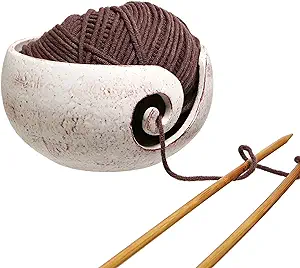
Tired of tangled yarn ruining your knitting groove?
Enter the handcrafted ceramic yarn bowl—a beautiful and functional solution.
Its wide opening makes it easy to access your yarn, while the cut-out design keeps your yarn flowing smoothly and tangle-free, just like magic.
Although some users find it a bit pricey and shipping can be slow, its charm and practicality make it worth the wait.
Perfect as a thoughtful gift for knitters and crocheters, this bowl elevates your crafting experience with a touch of elegance.
Best For: This ceramic yarn bowl is ideal for knitters and crocheters who want to keep their yarn tidy and tangle-free.
- Keeps yarn organized and tangle-free.
- Features a wide opening for easy yarn access.
- Makes a thoughtful gift for crafting enthusiasts.
- May not fit oblong skeins of yarn.
- Can be a bit pricey.
- Shipping can take up to 3 weeks.
2. Large Capacity Yarn Winder for Crocheting
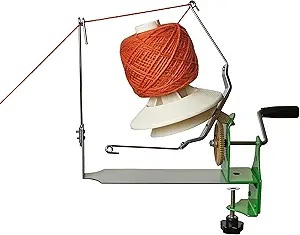
A large capacity yarn winder can be your best friend if you’re into crocheting and crave efficiency, especially when working with versatile worsted weight yarns like best yarn for durability.
The Olikraft Yarn Winder, with its robust stainless steel build, handles up to 16 ounces effortlessly.
It’s like having a reliable yarn-making companion that’s easy to assemble, though those nylon gears might keep you on your toes.
Quiet operation and versatility make it ideal for creating large, center-pull yarn cakes.
Just be mindful of its size when considering workspace compatibility.
Best For: This yarn winder is perfect for crocheters and knitters working with larger quantities of worsted weight yarn.
- Handles up to 16 ounces of yarn.
- Quiet operation for a peaceful crafting experience.
- Versatile for creating large center-pull yarn cakes.
- Nylon gears may not be as durable as metal gears.
- Some users reported issues with the clamp holding the stationary lead in arm.
- Assembly instructions may not be clear to all users.
3. Large Metal Yarn Ball Winder
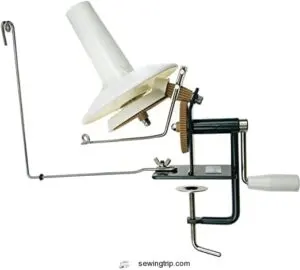
The Large Metal Yarn Ball Winder from Stanwood Needlecraft offers a robust solution for winding hefty 10-ounce skeins with ease.
Its ultra-heavy-duty construction, made of 3mm steel, guarantees durability while keeping noise to a minimum thanks to reinforced nylon gears.
You’ll appreciate its tool-less setup, which means you’ll be up and running in no time.
Though some users mention initial tightness, a quick screw adjustment can fix that.
Its center-pull design promises convenience, making it a must-have for serious knitters.
Best For: This sturdy winder is ideal for knitters and crocheters who work with larger quantities of yarn.
- Ultra-heavy-duty construction for durability
- Tool-less setup for easy assembly
- Center-pull design for convenient yarn access
- May require initial adjustment for optimal tension
- Can be louder than plastic winders
- Requires a table with sufficient space for clamping
4. Center Pull Yarn Winder Rosewood
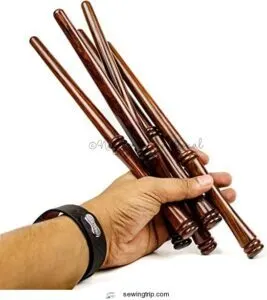
Imagine creating perfect yarn balls with the Center Pull Yarn Winder Rosewood.
This little gem, crafted from lush rosewood, feels like holding a piece of art.
Its portable design lets you stash it in any crafty corner, ready to whip up a tidy yarn ball from leftovers.
While it may require a bit of practice—like riding a bike for the first time—it’s a charming alternative to mechanical winders.
However, if your hands struggle with fine tasks, consider a more user-friendly option.
Best For: This yarn winder is best for crafters seeking a portable, hand-crafted option for winding smaller amounts of yarn, especially leftovers.
- Perfect for winding smaller amounts of yarn.
- Portable and easy to store.
- Made from beautiful, high-quality rosewood.
- May require practice to use effectively.
- Not suitable for people with motor skill problems.
- Can be more time-consuming than a mechanical winder.
5. Yarn Ball Winder Hand Operated 4 Ounce
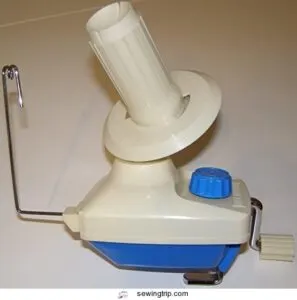
Whether you’re a yarn newbie or seasoned crafter, the Yarn Ball Winder Hand Operated 4 Ounce might just be your new favorite tool.
Its lightweight design and sturdy plastic build make it perfect for creating neat, center-pull balls.
But be mindful of delicate gears when handling large hanks—it’s a winder, not a bodybuilder!
With the capacity to handle various yarn types, including wool and blends, it’s a reliable choice.
Just make sure your table’s thin enough for the clamp, and you’ll be winding effortlessly.
Best For: This yarn ball winder is best for crafters of all levels who want a reliable and easy-to-use tool for creating center-pull yarn balls.
- Creates neat, center-pull yarn balls
- Can handle a variety of yarn types, including wool and blends
- Lightweight and sturdy design
- Delicate gears can be prone to breakage when handling large hanks
- Clamp only accommodates tables up to 1 1/2 inches thick
- Some users have reported issues with the wire arm staying in place
6. Hand Operated Yarn Ball Winder
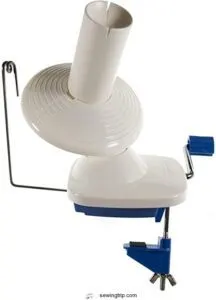
Some find hand-operated yarn winders surprisingly satisfying.
They offer a slower, more deliberate process, perfect for mindful crafting.
Consider the Stanwood Needlecraft, known for its smooth crank and sturdy build.
Alternatively, the Knit Picks winder provides a budget-friendly option.
Both create neat yarn cakes, but the Stanwood handles slightly heavier yarns.
Think about your yarn weight and budget when choosing.
You’ll appreciate the control and the perfectly formed yarn balls you create.
A hand-operated winder is a great way to take control of your yarn.
It’s a simple tool that can make a big difference in your crafting experience.
Best For: This yarn winder is best for crafters who prefer a slower, more deliberate winding process and work with lighter weight yarns.
- Creates neat yarn cakes for easy use.
- Durable and unbreakable metal crank.
- Smooth and quiet operation for a pleasant winding experience.
- May require manual tension control to prevent tangling.
- Compact size may not be ideal for larger yarn quantities.
- Best used with a yarn swift for optimal results.
7. Lacis Yarn Ball Winder Weaving Yarn
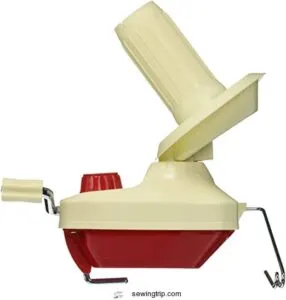
If you’re after a reliable helper for your yarn stash, the Lacis Yarn Ball Winder might just fit the bill.
Compact yet effective, it winds up yarn into neat cakes without tangles—perfect for hassle-free knitting or crocheting sessions.
Its small footprint makes it easy to store, though some users find it a bit tricky at first.
Despite a slight learning curve, many appreciate its sturdy build and even yarn flow.
Ideal for yarn enthusiasts who enjoy crafting without constant yarn drama.
Best For: The Lacis Yarn Ball Winder is best for knitters and crocheters who want a compact and easy-to-use yarn winder for making pull thread balls.
- Winds yarn into neat cakes without tangles.
- Easy to store due to its small footprint.
- Provides even yarn flow and prevents tangling.
- May have a learning curve for some users.
- Some users reported that the winder is a bit small.
- Some users reported that the winder does not work and makes a grinding noise.
8. Yarn Winder Holder for Hand Spinning
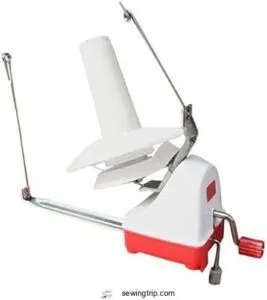
Ever grappled with loose yarn tangling mid-project?
A yarn winder holder for hand spinning might just be your new best friend.
Easy to install on any desk, it’s lightweight and convenient, making your yarn more compact and ready to store.
Although directions are a bit unclear, once you figure it out, assembly becomes a breeze, transforming large skeins into manageable yarn balls quickly.
Remember, patience is key—especially when dealing with yarn over five ounces.
Best For: This yarn winder holder is best for crafters who want to wind yarn into manageable balls for storage and use.
- Makes yarn more compact and easier to store.
- Works well for winding yarn into balls.
- Can be used to wind crochet thread off of cardboard rolls.
- Instructions are not very clear.
- Some users have reported issues with the spindle not staying put.
- Not suitable for yarn over 5 oz.
Understanding Motorized Yarn Winders
When you explore motorized yarn winders, you’re stepping into a world where winding yarn becomes as easy as pressing a button, letting the machine handle all the hard work.
With options like the Ashford Electric Yarn Ball Winder and the Hague PDB 250G, you’ll find these devices can save time, making them a great choice for busy crafters who appreciate a bit of automation in their lives.
Ashford Electric Yarn Ball Winder
When exploring yarn winders, the Ashford electric yarn ball winder stands out for convenience.
Here’s why it might just click for you:
- Speed: Quickly winds with consistent tension.
- Ease: Less manual hassle compared to traditional winders.
- Accessories: Customize with add-ons for varied needs.
Perfect for those seeking efficiency without sacrificing quality!
Diva Power Jumbo Ball Winder With Yarn Guide
A motorized yarn winder, like the Diva Power Jumbo Ball Winder with Yarn Guide, simplifies your crafting experience.
It makes winding large skeins a breeze, ensuring neat, compact yarn cakes.
Additionally, understanding common issues with motorized winders, such as bobbin winder problems issues, can help you troubleshoot and optimize your yarn winding process.
Check out Diva Power Jumbo Ball Winder reviews and consider features like the yarn guide benefits.
Electric models offer control, letting you focus on creativity and fun DIY upgrades.
Hague PDB 250G Electric Ball Winders
While the Diva Power Jumbo Ball Winder impresses with its yarn guide, the Hague PDB 250G Electric Ball Winders shine with speed and efficiency, helping you dominate the yarn stash.
If you’re in the market for a great yarn winder, check out the best options at top winder picks.
Consider these highlights:
- Speed & Noise: Surprisingly quiet, perfect for late-night crafting.
- Winder Maintenance: Low maintenance equals more knitting time.
- Comparison: Matches the Ashford’s performance, but at a friendlier price.
Simplicity Boye Winder
Remember the Simplicity Boye Winder? It’s a discontinued model, but don’t worry!
Many similar yarn winders offer similar functionality.
Check out user reviews for alternatives like the Knit Picks or Stanwood Needlecraft winders.
These offer great yarn organization and management for your yarn storage needs.
Finding a replacement is easier than you think!
You’ll regain control over your yarn chaos in no time.
Benefits of Using a Yarn Winder
You’ll love how a yarn winder can turn messy skeins into neat, untangled balls that are a breeze to work with, preventing knots and chaos.
It’s like having a magic wand for your yarn stash; no more escaping balls wreaking havoc on your living room!
Easier to Use Yarn Hanks
Transform your yarn hanks into tidy, manageable balls with ease by using a yarn winder.
Say farewell to the hassle of tangled skeins and hello to smooth winding techniques.
Whether you’re dealing with yarn hank storage or hank to ball conversions, a yarn baller or winder proves invaluable.
Swift alternatives and these tools make crafting a breeze, saving time and sanity.
Neat and Untangled Balls
Dealing with unruly yarn hanks? Yarn winders come to the rescue with neat, untangled balls that make knitting a breeze. Say goodbye to knots and frustration! Here’s why you’ll love them:
- Winding yarn evenly creates smooth knitting.
- DIY yarn ball for personal touch.
- Efficient storage saves space.
- Center-pull balls give stress-free knitting.
Easy to Work With
Using a yarn winder for yarn prep feels like having a friendly assistant by your side.
With its user-friendly design, this knitting tool eases your task, leaving you free to explore creative projects without the hassle.
Enjoy smooth operation and a comfortable grip, making yarn ball winder techniques a breeze for novices and seasoned knitters alike.
Prevents Rolling and Knotting
When you’ve got a yarn winder, you won’t find your just-wound yarn balls rolling under the couch, tangling like a cat’s plaything.
It’s a game changer, ensuring your projects run smoothly as your yarn stays neat, nestled, and knot-free.
You’ll love how it protects those delicate hanks, providing peace of mind and seamless organization.
How to Choose The Right Yarn Winder
Choosing the right yarn winder doesn’t have to be as tangled as your last yarn skein—just think about what’ll suit your crafting style best.
Whether you prefer a manual or electric winder, want a swift that’s adjustable, or need a winder that makes a hefty yarn cake, there’s a perfect match out there for every knitter.
Type of Swift
So, you’re ready to conquer those yarn hanks? Choosing between an umbrella or tabletop swift is your first step.
Umbrella swifts are portable and space-saving, perfect for smaller projects.
Tabletop swifts offer more stability and often handle larger yarn quantities.
Consider your yarn’s size and your workspace when making your choice.
Remember, swift compatibility with your yarn winder is key! Happy winding!
Adjustable Swift
Imagine your knitting setup with an adjustable swift; it adds flexibility and control to your yarn winding. Pick one with sturdy construction for lasting use.
- Swift types: Consider umbrella or tabletop designs.
- Swift features: Look for adjustable sizes.
- Swift brands: Check Stanwood or Knit Picks.
- Swift benefits: Helps with smooth yarn unwinding.
Manual or Electric Winder
Choosing between a manual or electric yarn winder is like picking between a trusty old bicycle and a shiny motorbike.
Manual winders are cost-effective and simple, offering more control and a classic feel.
You can find various types of yarn ball winders online, such as those on the yarn ball winder store.
Electric winders, on the other hand, boast speed and convenience, saving time but often costing more.
Consider your pace and budget when selecting your yarn winder.
Desired Cake Size
When you’re pondering cake size, consider how it impacts your yarn winder choice.
A bigger cake might mean less frequent winding, but it could also strain your winder’s capacity.
Factor in winding tension and yarn weight—especially with chunky or bulky yarns—to make sure the process goes smoothly.
It’s like choosing the perfect mug for your coffee; size matters more than you’d think!
Material Durability and Weight
Decisions, decisions! When picking a yarn winder, weighing durability vs. weight is important.
Heavy-duty needs may call for metal, while lighter options like wood suit quick, easy setups.
Consider the material impact on your yarn hobby; wood is a warm companion, while metal stands tough.
Whether crafting tools or crocheting accessories, find the right fit for your fiber supplies.
Tips for Using a Yarn Winder
Using a yarn winder can feel like a breeze when you know a few handy tips, even if you don’t have a swift at hand.
You’ll soon wonder how you ever managed those unruly skeins before, and believe me, your cat won’t miss the rolling yarn balls either!
Using a Winder Without a Swift
Sometimes, using a yarn winder without a swift feels like juggling, but it’s doable.
When working with various materials like vinyl, mastering techniques such as sewing vinyl leather can help you tackle challenging projects; embrace creativity; you might even master DIY solutions for winding techniques.
Here’s how:
- Use chair backs as makeshift swifts.
- Employ helpful hands for holding skeins.
- Handle yarn tension carefully to avoid tangles.
- Try patience; it’s key in fiber crafts.
Worth of Investment
So, you’ve mastered swift-less winding.
Now, about that Yarn Winder Cost… Think of it as an investment, not an expense!
A good yarn winder saves you time, frustration, and potentially money on tangled yarn.
Many affordable options exist, offering great value for money.
It’s a money-saving tool for serious crafters and DIY enthusiasts alike.
For fiber artists, it’s a game-changer.
The return on investment is quick – you’ll recoup the cost in saved time and yarn.
Plus, handmade projects are worth it!
Purpose of Rolling Yarn
Exploring the worth of this investment might leave you curious about why rolling yarn matters.
Rolling yarn offers a practical approach to yarn storage, ensuring tangle-free knitting.
It allows for center-pull ease, maintaining consistent tension and boosting project efficiency.
You won’t have to wrestle with pesky knots or runaway balls—just smooth, uninterrupted crafting bliss.
Reason for Not Selling Yarn in Balls
When thinking about yarn, it’s curious they don’t sell it in handy balls.
Here’s why:
1. Cost: Balling yarn increases production costs, raising the retail price.
2. Storage: Hanks are more compact and efficient for storage.
3. Tangles: Yarn in hanks stays neater, making it more convenient to handle.
These factors make skeins a smart choice for sellers.
Frequently Asked Questions (FAQs)
Which yarn winder is best?
Choosing a yarn winder is like picking the perfect dance partner: Stanwood Needlecraft Compact Yarn Ball Winder YBW-A takes the lead.
It’s durable and user-friendly, making yarn untangling a breeze and ensuring hassle-free crafting.
What is a yarn winder?
It’s a handy tool that neatly winds yarn into balls.
You’ll avoid tangled messes and enjoy easier knitting or crocheting.
Think of it as your yarn’s personal stylist!
Many types exist, so find one that fits your needs.
What is the best electric yarn ball Winder?
Exploring electric yarn winders, you’ll find the Ashford Electric Yarn Ball Winder offers quiet versatility with adjustable speeds, perfect for prim and proper balls.
It’s perfect if you’ve got a pile of yarn waiting for some magic.
Which is the best Jumbo yarn winder?
You might love the Maple Jumbo Ball Winder for its user-friendliness and handcrafted quality.
Perfect for winding large skeins, it handles bulky yarn effortlessly.
Plus, it supports small businesses while making your yarn adventures smoother!
Is it worth winding yarn?
Winding yarn helps keep it tangle-free, neat, and easy to work with.
While it might seem like extra work initially, you’ll appreciate the convenience, especially when handling skeins.
It’s a game-changer for serious knitters.
What is the difference between a yarn swift and a ball winder?
Taming the yarn chaos, a yarn swift helps hold and unfold skeins, while a ball winder spins tidy cakes.
They partner to keep your yarn untangled, making your knitting, crocheting, or weaving adventures smooth and hassle-free.
Can you use a yarn ball winder without a swift?
Definitely, a yarn ball winder works fine without a swift, though it requires a bit more effort.
You’ll need to hand-feed the yarn while winding, which can feel like a juggler’s task but it’s manageable!
Does a yarn winder save space?
Yarn winders do save space by turning those bulky skeins into compact, stackable balls that won’t roll away.
Imagine your yarn stash neatly organized!
It’s like giving your shelves a much-needed makeover—practical and satisfying.
How do I maintain my yarn winder?
Maintaining your yarn winder‘s a breeze!
It’s practically self-cleaning, but wiping it down after each use prevents yarn buildup.
Occasionally oiling the moving parts helps it run smoothly.
That’s it!
You’re golden.
Can a yarn winder handle delicate yarns?
Absolutely, a yarn winder can handle delicate yarns, but you should crank slowly to avoid tangling.
Consider using a winder with smooth gears and a gentle tension arm, and feel like you’re spinning pure magic.
What are common issues with yarn winders?
When dealing with yarn winders, you might encounter tangling, uneven tension, and slipping yarn.
These hiccups can mess with your crafting mojo, but choosing a sturdy model reduces glitches, keeping your projects smooth and frustration-free.
How long does a yarn winder last?
Ever wondered how long a yarn winder lasts?
It can last many years, especially if you opt for a sturdy model and maintain it well.
Look for ones with durable materials like metal; they’ll wind your yarn hassle-free.
Can I wind yarn without a swift?
You can definitely use a yarn winder and best yarn swift to make the process more efficient, but wind yarn without a swift.
Just drape the skein around your knees or a chair back, and use a ball winder or your hands.
It’s a bit more hands-on, but totally doable!
Conclusion
With 78% of crafters agreeing that the right tools enhance their projects, picking the best yarn winder is a game-changer for your knitting routine.
Whether you prefer a manual model’s simplicity or the speed of an electric winder, there’s something for everyone.
Consider the material, cake size, and setup to transform your yarn storage.
Invest in a quality yarn winder, and say goodbye to tangles and chaos.
Your organized yarn adventure starts now!

